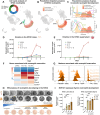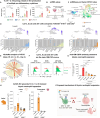TL1A and IL-18 synergy promotes GM-CSF-dependent thymic granulopoiesis in mice
- PMID: 38839915
- PMCID: PMC11291760
- DOI: 10.1038/s41423-024-01180-8
TL1A and IL-18 synergy promotes GM-CSF-dependent thymic granulopoiesis in mice
Abstract
Acute systemic inflammation critically alters the function of the immune system, often promoting myelopoiesis at the expense of lymphopoiesis. In the thymus, systemic inflammation results in acute thymic atrophy and, consequently, impaired T-lymphopoiesis. The mechanism by which systemic inflammation impacts the thymus beyond suppressing T-cell development is still unclear. Here, we describe how the synergism between TL1A and IL-18 suppresses T-lymphopoiesis to promote thymic myelopoiesis. The protein levels of these two cytokines were elevated in the thymus during viral-induced thymus atrophy infection with murine cytomegalovirus (MCMV) or pneumonia virus of mice (PVM). In vivo administration of TL1A and IL-18 induced acute thymic atrophy, while thymic neutrophils expanded. Fate mapping with Ms4a3-Cre mice demonstrated that thymic neutrophils emerge from thymic granulocyte-monocyte progenitors (GMPs), while Rag1-Cre fate mapping revealed a common developmental path with lymphocytes. These effects could be modeled ex vivo using neonatal thymic organ cultures (NTOCs), where TL1A and IL-18 synergistically enhanced neutrophil production and egress. NOTCH blockade by the LY411575 inhibitor increased the number of neutrophils in the culture, indicating that NOTCH restricted steady-state thymic granulopoiesis. To promote myelopoiesis, TL1A, and IL-18 synergistically increased GM-CSF levels in the NTOC, which was mainly produced by thymic ILC1s. In support, TL1A- and IL-18-induced granulopoiesis was completely prevented in NTOCs derived from Csf2rb-/- mice and by GM-CSFR antibody blockade, revealing that GM-CSF is the essential factor driving thymic granulopoiesis. Taken together, our findings reveal that TL1A and IL-18 synergism induce acute thymus atrophy while promoting extramedullary thymic granulopoiesis in a NOTCH and GM-CSF-controlled manner.
Keywords: Cytokine synergy; Emergency granulopoiesis; Thymic GMP; Thymic Neutrophils; Thymus atrophy.
© 2024. The Author(s).
Conflict of interest statement
The authors declare no competing interests.
Figures







References
-
- Liang KL, Roels J, Lavaert M, Putteman T, Boehme L, Tilleman L, et al. Intrathymic dendritic cell-biased precursors promote human T cell lineage specification through IRF8-driven transmembrane TNF. Nat Immunol. 2023;24:474–86. 10.1038/s41590-022-01417-6. - PubMed
MeSH terms
Substances
Grants and funding
- G.0B96.20N/Fonds Wetenschappelijk Onderzoek (Research Foundation Flanders)
- 11A7222N/Fonds Wetenschappelijk Onderzoek (Research Foundation Flanders)
- G.0C76.18N/Fonds Wetenschappelijk Onderzoek (Research Foundation Flanders)
- G.0B71.18N/Fonds Wetenschappelijk Onderzoek (Research Foundation Flanders)
- MA 7770/1-1/Deutsche Forschungsgemeinschaft (German Research Foundation)
LinkOut - more resources
Full Text Sources
Molecular Biology Databases
Research Materials
Miscellaneous

